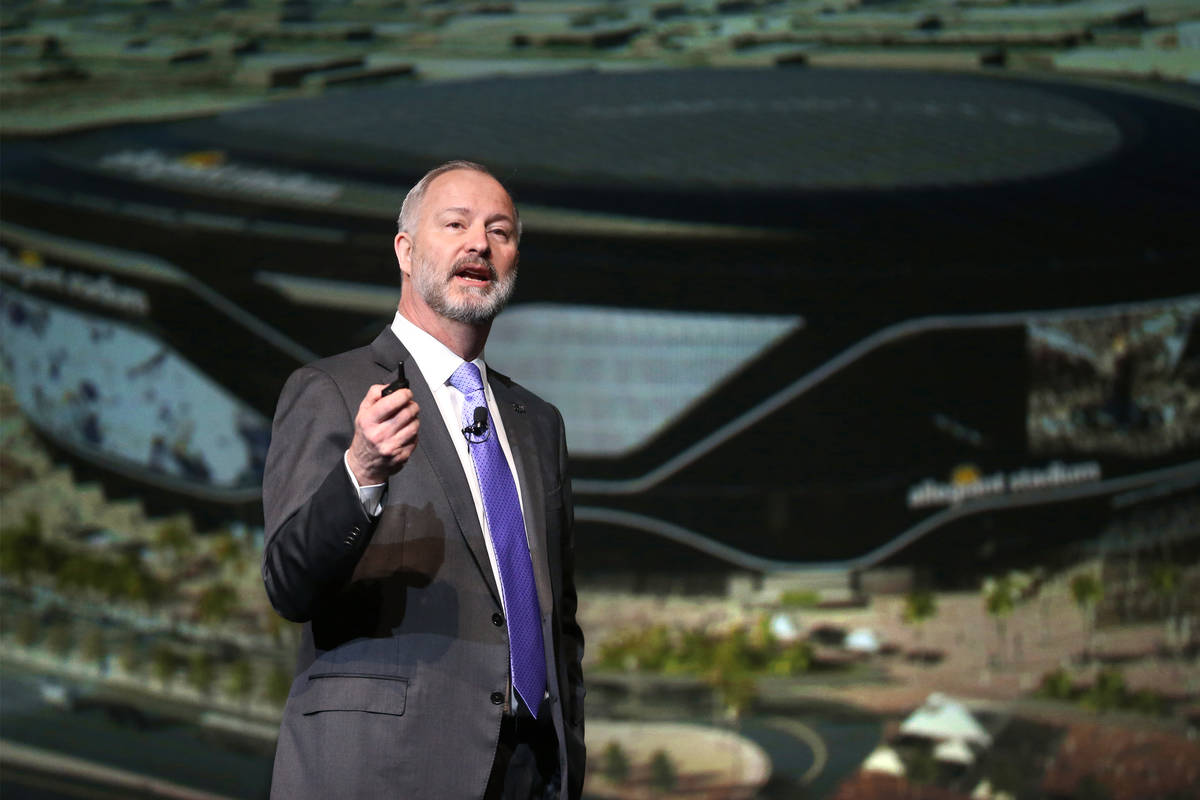Steve Hill: Allegiant ‘seems to be a great fit for Las Vegas’
Steve Hill has been pretty busy over the last five years.
The former director of Gov. Brian Sandoval’s Governor’s Office of Economic Development, Hill was the one Sandoval turned to in 2015 when he established the Southern Nevada Tourism Infrastructure Committee, an 11-member board with six technical advisers tasked with compiling a list of tourism improvements, including a football stadium that could also be used by UNLV.
Once the committee issued its recommendations to the governor, Hill was selected by Sandoval to chair the Las Vegas Stadium Authority, the public overseer of an effort to build an NFL-caliber stadium.
Along the way, Hill left the Governor’s Office of Economic Development and joined the Las Vegas Convention and Visitors Authority, where he is now president and CEO.
In this Q&A with Hill on July 21, he looks back at the Stadium Authority’s role in Allegiant Stadium’s development.
Review-Journal: When this process started in 2015, did you ever think that you would have such a prominent role in the development of Allegiant Stadium?
Steve Hill: The reality is, I was surrounded by a lot of really dedicated people and groups that were committed to this project. (Owner) Mark Davis, (President) Marc Badain and Don Webb of the Raiders certainly played big roles. Gov. Sandoval and now Gov. (Steve) Sisolak, Commissioner Sisolak when he was on the Tourism Infrastructure Committee. Jeremy (Aguero, principal for Applied Analysis) and his team certainly are important.
All the leaders at Mortenson (Construction) and McCarthy (Builders). Everybody at the LVCVA was making the (Las Vegas Convention Center expansion) work while this project was going on at the same time. I’ve probably missed somebody in there. (Las Vegas Sands Chairman) Sheldon (Adelson) was certainly a major reason this got done and all the members of the Tourism Infrastructure Committee itself. We had a great team working this. It was great to be a part of.
What was the most difficult aspect of getting the project completed?
You’ve got to remember that when this was taken to the Legislature, we weren’t even sure that the Raiders were going to be allowed to come here. You have to give the Raiders credit for convincing the NFL that Las Vegas would support them. Toward the end, there were additional challenges brought about by the pandemic. The contractors and the subcontractors had to adjust their schedules and implement protocols at a pretty critical time during construction.
Was there ever a point when you had doubts that the stadium would get built on time?
Oh, for sure. First, there was a disruption in steel supply. The contractors had to get steel from several different sources, and several months went by when steel didn’t arrive when it was needed. If you can’t build the stadium superstructure, it makes it difficult to maintain the schedule, but Mortenson-McCarthy made it work. There were also some concerns with the stadium roof when construction got to that point. The first effort to lift the roof cable system didn’t work correctly, causing the roof installation to be delayed. This always was considered the most difficult part of the project. I know everybody felt a lot better once that got done.
Can you explain the public’s ownership position of the stadium once it’s occupied?
The stadium is owned by the Stadium Authority; in essence, it’s owned by the people of Nevada. The Raiders have the right to program and run the stadium during the 30-year term of the lease we have in place. They are required to stay through that 30-year period. If they don’t, the penalty is that they have to pay off any remaining bonds that are still owed if they leave.
The Raiders are also responsible to maintain the stadium through the lease period. The Stadium Authority’s responsibility will be to make sure that the agreement and what was put into law by the Legislature is upheld. It needs to be a premier world-class stadium and remain that way. It needs to be maintained well. We need to make sure that UNLV can play there and that it is a home environment for UNLV. Those are the headline responsibilities the Stadium Authority has. It must be sure the law as it was passed is implemented correctly.
What’s the first event Steve Hill will attend at Allegiant Stadium?
It will be the first event that the public is allowed to be at. Whatever that is, I will certainly be there for it. I was excited about what I thought the stadium was going to mean prior to the virus showing up. Now, I’m even more excited because it’s going to be a significant aspect of our recovery. Everybody wants to be here and play in that stadium, whether that’s playing a sport or playing their instrument. It’s going to be a real draw and an important part of the recovery of Las Vegas.
When was the last time you were inside the building?
Just last week. I think the outside is spectacular, but the inside is great. I think they’ve designed a stadium for Vegas. It’s kind of like the Golden Knights atmosphere where you feel like you’re having a party and a hockey game breaks out. I think the stadium is going to be the same way. There’s a great club being built at the north end zone. There are spectacular gathering places so big groups of people can be together and enjoy what’s happening in the stadium. I think that’s different from most any other stadium I’ve been in. It seems to be a great fit for Las Vegas and everything that Las Vegas brings to events.
The Review-Journal is owned by the family of Las Vegas Sands Corp. Chairman and CEO Sheldon Adelson. Las Vegas Sands operates The Venetian, Palazzo and the Sands Expo and Convention Center in Las Vegas.
Contact Richard N. Velotta at rvelotta@reviewjournal.com or 702-477-3893. Follow @RickVelotta on Twitter.


















